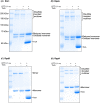Thiol redox switches regulate the oligomeric state of cyanobacterial Rre1, RpaA and RpaB response regulators
- PMID: 35353903
- PMCID: PMC9321951
- DOI: 10.1002/1873-3468.14340
Thiol redox switches regulate the oligomeric state of cyanobacterial Rre1, RpaA and RpaB response regulators
Abstract
Cyanobacteria employ two-component sensor-response regulator systems to monitor and respond to environmental challenges. The response regulators RpaA, RpaB, Rre1 and RppA are integral to circadian clock function and abiotic stress acclimation in cyanobacteria. RpaA, RpaB and Rre1 are known to interact with ferredoxin or thioredoxin, raising the possibility of their thiol regulation. Here, we report that Synechocystis sp. PCC 6803 Rre1, RpaA and RpaB exist as higher-order oligomers under oxidising conditions and that reduced thioredoxin A converts them to monomers. We further show that these response regulators contain redox-responsive cysteine residues with an Em7 around -300 mV. These findings suggest a direct thiol modulation of the activity of these response regulators, independent of their cognate sensor kinases.
Keywords: Hik2; RpaA; RpaB; Rre1; TrxA; thiol regulation.
© 2022 The Authors. FEBS Letters published by John Wiley & Sons Ltd on behalf of Federation of European Biochemical Societies.
Conflict of interest statement
The authors declare no conflict of interest.
Figures




Similar articles
-
Identification of OmpR-family response regulators interacting with thioredoxin in the Cyanobacterium Synechocystis sp. PCC 6803.PLoS One. 2015 Mar 16;10(3):e0119107. doi: 10.1371/journal.pone.0119107. eCollection 2015. PLoS One. 2015. PMID: 25774906 Free PMC article.
-
Cross-talk and regulatory interactions between the essential response regulator RpaB and cyanobacterial circadian clock output.Proc Natl Acad Sci U S A. 2015 Feb 17;112(7):2198-203. doi: 10.1073/pnas.1424632112. Epub 2015 Feb 4. Proc Natl Acad Sci U S A. 2015. PMID: 25653337 Free PMC article.
-
Conserved two-component Hik34-Rre1 module directly activates heat-stress inducible transcription of major chaperone and other genes in Synechococcus elongatus PCC 7942.Mol Microbiol. 2017 Apr;104(2):260-277. doi: 10.1111/mmi.13624. Epub 2017 Feb 15. Mol Microbiol. 2017. PMID: 28106321
-
Cyanobacteria in motion.Curr Opin Plant Biol. 2017 Jun;37:109-115. doi: 10.1016/j.pbi.2017.03.018. Epub 2017 May 1. Curr Opin Plant Biol. 2017. PMID: 28472718 Review.
-
Disulphide proteomes and interactions with thioredoxin on the track towards understanding redox regulation in chloroplasts and cyanobacteria.J Proteomics. 2009 Apr 13;72(3):416-38. doi: 10.1016/j.jprot.2009.01.003. Epub 2009 Jan 13. J Proteomics. 2009. PMID: 19185068 Review.
Cited by
-
To Die or Not to Die-Regulated Cell Death and Survival in Cyanobacteria.Microorganisms. 2022 Aug 17;10(8):1657. doi: 10.3390/microorganisms10081657. Microorganisms. 2022. PMID: 36014075 Free PMC article. Review.
-
A novel insight into ComE-mediated activation of gene expression in Streptococcus mutans.Microbiol Spectr. 2025 Aug 5;13(8):e0147725. doi: 10.1128/spectrum.01477-25. Epub 2025 Jul 7. Microbiol Spectr. 2025. PMID: 40621915 Free PMC article.
-
A phosphorylation signal activates genome-wide transcriptional control by BfmR, the global regulator of Acinetobacter resistance and virulence.bioRxiv [Preprint]. 2024 Jul 1:2024.06.16.599214. doi: 10.1101/2024.06.16.599214. bioRxiv. 2024. Update in: Nucleic Acids Res. 2025 Feb 08;53(4):gkaf063. doi: 10.1093/nar/gkaf063. PMID: 38948834 Free PMC article. Updated. Preprint.
-
A phosphorylation signal activates genome-wide transcriptional control by BfmR, the global regulator of Acinetobacter resistance and virulence.Nucleic Acids Res. 2025 Feb 8;53(4):gkaf063. doi: 10.1093/nar/gkaf063. Nucleic Acids Res. 2025. PMID: 39921563 Free PMC article.
-
The redox-sensitive R-loop of the carbon control protein SbtB contributes to the regulation of the cyanobacterial CCM.Sci Rep. 2024 Apr 3;14(1):7885. doi: 10.1038/s41598-024-58354-7. Sci Rep. 2024. PMID: 38570698 Free PMC article.
References
-
- Mary I, Vaulot D. Two‐component systems in Prochlorococcus MED4: genomic analysis and differential expression under stress. FEMS Microbiol Lett. 2003;226:135–44. - PubMed
-
- Ashby MK, Mullineaux CW. Cyanobacterial ycf27 gene products regulate energy transfer from phycobilisomes to photosystems I and II. FEMS Microbiol Lett. 1999;181:253–60. - PubMed
-
- Laub MT, Goulian M. Specificity in two‐component signal transduction pathways. Annu Rev Genet. 2007;41:121–45. - PubMed
Publication types
MeSH terms
Substances
Grants and funding
LinkOut - more resources
Full Text Sources
Molecular Biology Databases

